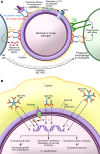Pathogen-specific antibodies: codependent no longer
- PMID: 20335652
- PMCID: PMC2846075
- DOI: 10.1172/JCI42695
Pathogen-specific antibodies: codependent no longer
Abstract
Antibody-mediated defense against pathogens typically requires complex interactions between antibodies and other constituents of the humoral and cellular immune systems. However, recent evidence indicates that some antibodies alone can inhibit pathogen function in the absence of complement, phagocytes, or NK cells. In this issue of the JCI, McClelland et al. have begun to elucidate the molecular bases by which antibodies alone can impact pathogen growth and metabolism. They show that mAbs specific for the polysaccharide capsule of the human pathogenic fungus Cryptococcus neoformans elicit diverse effects on fungal gene expression, lipid biosynthesis, susceptibility to amphotericin B, cellular metabolism, and protein phosphorylation. These data suggest that pathogens have the capacity to generate broad metabolic responses as a result of surface binding by pathogen-specific antibodies, effects that may hold therapeutic promise.
Figures

Comment on
-
Ab binding alters gene expression in Cryptococcus neoformans and directly modulates fungal metabolism.J Clin Invest. 2010 Apr;120(4):1355-61. doi: 10.1172/JCI38322. Epub 2010 Mar 24. J Clin Invest. 2010. PMID: 20335660 Free PMC article.
References
-
- Silverstein AM.A History of Immunology. San Diego, CA: Academic Press, Inc; 1989.
-
- Park BJ, Wannemuehler KA, Marston BJ, Govender N, Pappas PG, Chiller TM. Estimation of the current global burden of cryptococcal meningitis among persons living with HIV/AIDS. AIDS. 2009;23(4):525–530. - PubMed

